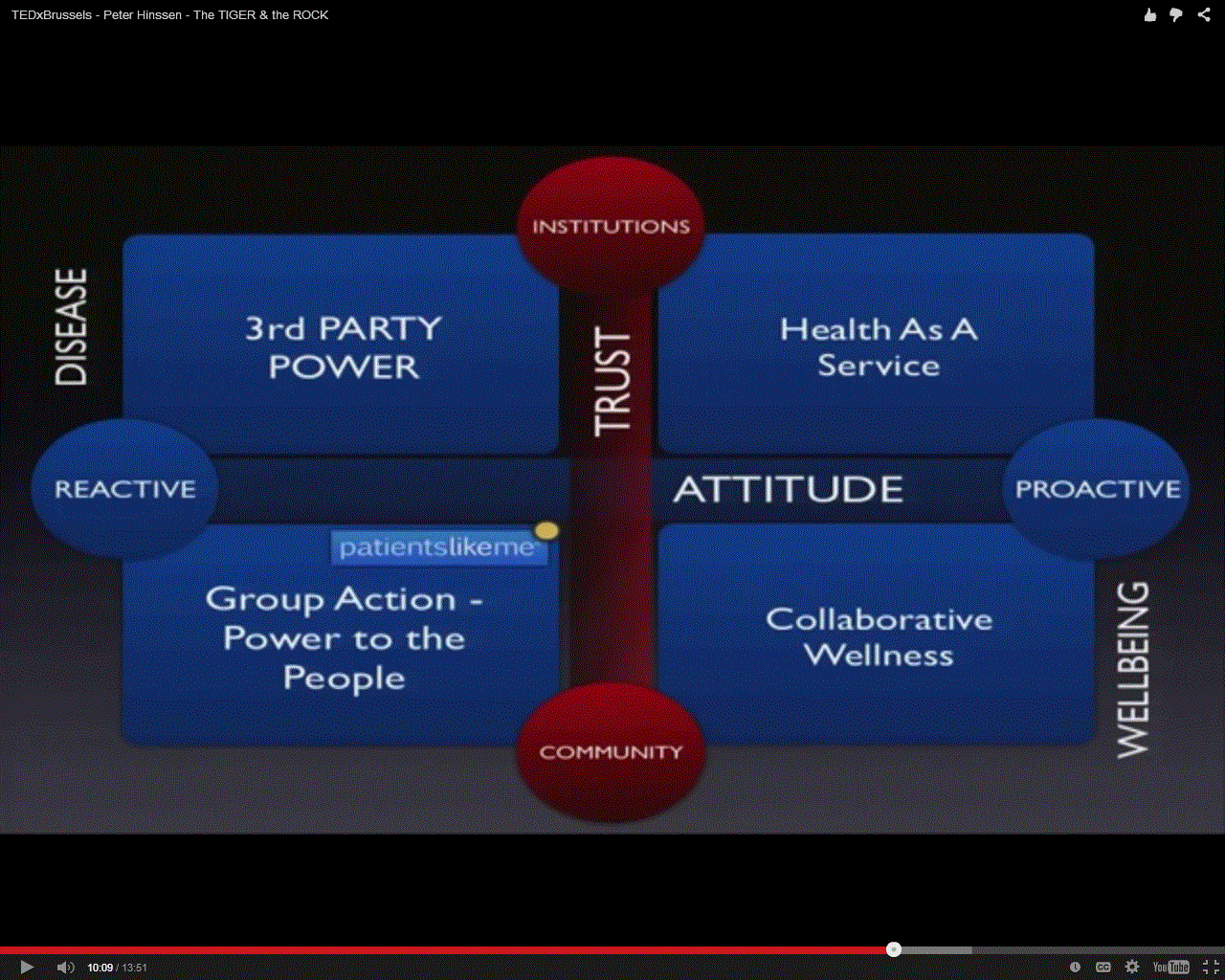
Category Archives: nutrition
Peter Hinssen: The Tiger and The Rock
EDxBrussels – Peter Hinssen – The TIGER & the ROCK
Why Extrapolating WON’T WORK & What it means for HEALTH http://www.tedxbrussels.eu About TEDx, x = independently organized event In the spirit of ideas worth…
http://wn.com/tedxbrussels_-_peter_hinssen_-_the_tiger_&_the_rock
8:20 – The Contiguous United States – macdonald’s proximity to people in the US
9:10 The Flip: Pharma moving to Health as a Service (no longer a product)
Institutions > Communities (trust)
Reactive > Proactive (attitude)
http://www.datapointed.net/visualizations/maps/distance-to-nearest-mcdonalds-sept-2010/
Should we pay people to look after their health?
http://theconversation.com/should-we-pay-people-to-look-after-their-health-24012
Should we pay people to look after their health?

With the Tony Abbott government expressing concern about the growing health budget and emphasising personal responsibility, perhaps it’s time to consider some creative ways of curbing what Australia spends on ill health. One solution is to pay people to either get well or avoid becoming unwell in the first instance.
The United Kingdom is already doing this kind of thing with a current trial of giving mothers from disadvantaged suburbs A$340 worth of food vouchers for breastfeeding newborn babies. And from January 1 this year, employers in the United Statescan provide increasingly significant rewards to employees for having better health outcomes, as part of the Affordable Care Act.
But should people really be paid to make healthy choices? Shouldn’t they be motivated to improve their health on their own anyway?
Encouraging right decisions
People don’t do what’s in their best interest in the long term for many reasons. When making decisions we tend to take mental short cuts; we allow the desires and distractions of the moment get in the way of pursuing what’s best.
One such “irrationality” is our tendency to focus on the immediate benefits or costs of a situation while undervaluing future consequences. Known as present bias, this is evident every time you hit the snooze button instead of going for a morning jog.
Researchers have found effective incentive programs can offset present bias by providing rewards that make it more attractive to make the healthy choice in the present.
Research conducted in US workplaces, for instance, found people who were given US$750 to quit smoking were three times more successful than those who weren’t given any incentives. Even after the incentive was removed for six months, there was still a quit rate ratio of 2.6 between the incentive and control groups – 9.4% of the incentive group stayed cigarette-free versus only 3.6% of the control group.
A refined approach
Still, while research on using financial incentives to encourage healthy behaviours is promising, it isn’t as straightforward as doling out cash in exchange for good behaviour.
Standard economic theory posits that the higher the reward, the bigger the impact – but this is only one ingredient to success. Behavioural economics shows that when and how you distribute incentives can determine the success of the program.
Here are a few basic principles to consider. First, small rewards can have a big impact on behaviour if they’re provided frequently and soon after the healthy choice is made. We have found this to be true in the context of weight-loss programs, medication adherence, and even to quit the use of drugs such as cocaine.
Games of chance are an effective way of distributing rewards as research has found people tend to focus on the value of the reward rather than their chance of winning the prize. Many people think that a 0.0001 and a 0.0000001 chance of winning a prize are roughly equivalent even though in reality they are vastly different probabilities.
Finally, people are more influenced by the prospect of losses than by gains. Studies show people put much greater weight on losing something than gaining something of a similar value.
In one weight-loss experiment, for instance, participants were asked to place money into a deposit account. If they didn’t achieve their weight goals, the money would be forfeited, but if they were successful, the initial deposit would be doubled and theirs to keep.
Reluctant to lose their deposits, participants in the deposit group lost over three times more weight than the control group, who were simply weighed each month.
Creating good habits
Incentives are particularly effective at changing one-time behaviours, such as encouraging vaccination or attendance at health screenings. But with increasing rates of obesity and other lifestyle-related diseases, we need to focus on how incentives can be used to achieve habit formation and long-term sustained weight loss.
We know financial incentives can increase gym usage and positively impact weight, waist size and pulse rate, but how to sustain gym use after the incentive is removed? The key may be to use incentives to achieve a high frequency of attendance for long enough to create a healthy habit.
We also need to consider how we can leverage social incentives, such as peer support and recognition, together with new technologies to maximise the impact of incentive-based programs.
Innovative solutions, like paying people to encourage the right health choices, may help to reduce both the health and economic impact of Australia’s growing burden of disease.
What 200 Calories Look Like In Different Foods
What 200 Calories Look Like In Different Foods
940K views
Apples (385 grams / 13.5 oz)
Butter (28 grams / 0.98 oz)
Broccoli (588 grams / 20.7 oz)
Snickers Chocolate Bar (41 grams / 1.45 oz)
Cooked Pasta (145 grams / 5.11 oz)
Hot Dogs (66 grams / 2.33 oz)
Kiwi Fruit (328 grams / 11.6 oz)
Jack in the Box Cheeseburger (75 grams / 2.6 oz)
Eggs (150 grams / 5.3 oz)
Celery (1425 grams / 50.3 oz)
Blackberry Pie (56 grams / 1.97 oz)
Mini Peppers (740 grams / 26.1 oz)
Canned Black Beans (186 grams / 6.56 oz)
Werther’s Originals Candy (50 grams / 1.76 oz)
Jack in the Box Chicken Sandwich (72 grams / 2.5 oz)
Glazed Doughnut (52 grams / 1.8 oz)
French Sandwich Roll (72 grams / 2.5 oz)
Avocado (125 grams / 4.4 oz)
Canned Sweet Corn (308 grams / 10.9 oz)
Baby Carrots (570 gram / 20.1 oz)
Canned Green Peas (357 grams / 12.6 oz)
Canned Pork and Beans (186 grams / 6.56 oz)
Doritos (41 grams / 1.44 oz)
Dried Apricots (83 grams / 2.9 oz)
Jack in the Box French Fries (73 grams / 2.6 oz)
Fried Bacon (34 grams / 1.2 oz)
Fruit Loops Cereal (51 grams / 1.8 oz)
Grapes (290 grams / 10.2 oz)
Splenda Artifical Sweetener (50 grams / 1.8 oz)
Gummy Bears (51 grams / 1.8 oz)
Hershey Kisses (36 grams / 1.27 oz)
Honeydew Melon (553 grams / 19.5 oz)
Jelly Belly Jelly Beans (54 grams / 1.9 oz)
Ketchup (226 grams / 7.97 oz)
M&M Candy (40 grams / 1.4 oz)
Red Onions (475 grams / 16.75 oz)
Sliced Smoked Turkey (204 grams / 7.2 oz)
Coca Cola (496 ml / 16.77 oz)
Canola Oil (23 grams / 0.8 oz)
Smarties Candy (57 grams / 2 oz)
Tootsie Pops (68 grams / 2.4 oz)
Whole Milk (333 ml / 11.3 fl oz)
Balsamic Vinegar (200 ml / 6.8 fl oz)
Lowfat Strawberry Yogurt (196 grams / 6.9 oz)
Canned Chili con Carne (189 grams / 6.7 oz)
Canned Tuna Packed in Oil (102 grams / 3.6 oz)
Fiber One Cereal (100 grams / 3.5 oz)
Flax Bread (90 grams / 3.17 oz)
Blueberry Muffin (72 grams / 2.5 oz)
Bailey’s Irish Cream (60 ml / 2.02 fl oz)
Cranberry Vanilla Crunch Cereal (55 grams / 1.9 oz)
Cornmeal (55 grams / 1.94 oz)
Wheat Flour (55 grams / 1.94 oz)
Peanut Butter Power Bar (54 grams / 1.9 oz)
Puffed Rice Cereal (54 grams / 1.9 oz)
Puffed Wheat Cereal (53 grams / 1.87 oz)
Brown Sugar (53 grams / 1.87 oz)
Salted Pretzels (52 grams / 1.83 oz)
Medium Cheddar Cheese (51 grams / 1.8 oz)
Potato Chips (37 grams / 1.3oz)
Sliced and Toasted Almonds (35 grams / 1.23 oz)
Peanut Butter (34 grams / 1.2 oz)
Salted Mixed Nuts (33 grams / 1.16 oz)
RWJF continues to go large on childhood obesity
http://www.rwjf.org/en/about-rwjf/newsroom/newsroom-content/2015/02/rwjf_doubles_commitment_to_healthy_weight_for_children.html
Robert Wood Johnson Foundation Doubles Its Commitment to Helping All Children Grow Up at a Healthy Weight
RWJF dedicates a total of $1 billion since 2007 to ensuring that all children have access to healthier foods and opportunities to be physically active.
February 5, 2015
Princeton, N.J.―Recognizing that obesity remains one of the biggest threats to the health of our children, the Robert Wood Johnson Foundation (RWJF) today announced it will commit $500 million over the next ten years to expand efforts to ensure that all children in the United States—no matter who they are or where they live―can grow up at a healthy weight. Building on a $500 million commitment made in 2007, the nation’s largest health philanthropy will have dedicated more than $1 billion to reversing the childhood obesity epidemic. Encouraged by recent signs of progress in turning rates around, RWJF views this investment as critical to building a Culture of Health in communities across the United States.
With this new $500 million pledge, RWJF signals its commitment to expand and accelerate that progress, with an intensified focus on those places and populations hardest hit by the epidemic. New work will advance strategies that help eliminate health disparities that contribute to higher obesity rates among children of color and children living in poverty across the United States. The Foundation also announced an expanded focus on preventing obesity in early childhood and on engaging parents, youth and health care providers to be active champions for healthier communities and schools.
Over the last decade, RWJF has been a leader in supporting nationwide efforts to change policies and school and community environments in ways that make the healthy choice the easy choice for children and families. Working in partnership with other funders and leaders in a variety of sectors, key initiatives enabled schools nationwide to transform their campuses into healthier places for kids and helped communities expand access to nutritious foods and safe places to be active. States and cities ranging from California to Mississippi, and New York City to Anchorage, Alaska, have begun reporting declining childhood obesity rates.
“By 2025, we want to ensure that children in America grow up at a healthy weight, no matter who they are or where they live,” said RWJF President and CEO Risa Lavizzo-Mourey, MD. “We have made substantial progress, but there is far more to do and we can’t stop now. This commitment is part of the Foundation’s effort to build a Culture of Health in every community across the country. We all have a role to play in our homes, schools, and neighborhoods to ensure that all kids have healthy food and safe places to play.”
Building on work the Foundation has implemented previously, RWJF will support research, action and advocacy strategies focused on the following priorities over the next decade:
- Ensure that all children enter kindergarten at a healthy weight.
- Make a healthy school environment the norm and not the exception across the United States.
- Make physical activity a part of the everyday experience for children and youth.
- Make healthy foods and beverages the affordable, available, and desired choice in all neighborhoods and communities.
- Eliminate the consumption of sugar-sweetened beverages among 0-5 year olds.
This new $500 million commitment represents a major investment in the Foundation’s broader effort to build a nationwide Culture of Health that enables all in our diverse society to lead healthier lives, now and for generations to come. Integral to building a strong Culture of Health is helping all children achieve and maintain a healthy weight to give them the strongest start toward a healthy future. This will require greater collaboration among businesses, government, individuals, and organizations to create communities that offer ample opportunities for parents and kids to make choices that help them live the healthiest lives possible.
RWJF’s new commitment follows a series of research reports showing progress toward reversing the childhood obesity epidemic. On a national level, childhood obesity rates have begun to level off, according to the Centers for Disease Control and Prevention (CDC). The CDC also released data last year showing rates may be decreasing among the nation’s youngest children. In addition, states from California to Mississippi and cities from Anchorage to Philadelphia have reported reductions in childhood obesity rates.
But these initial reports of declines follow decades of increases. Despite the recent positive news, more than one third of young people are overweight or obese—a rate far higher than it was a generation ago. African-American and Latino youth continue to have higher obesity rates than their white peers, even in most areas reporting overall progress. Among the cities and states reporting good news on obesity, only Philadelphia has measured progress toward narrowing disparity gaps. In that city, childhood obesity rates have declined overall, and the steepest drops have been among African-American boys and Latino girls, two groups with historically high obesity rates.
“The Robert Wood Johnson Foundation is in this fight for the long haul to ensure that all kids grow up at a healthy weight,” said Roger S. Fine, JD, chairman of the RWJF Board of Trustees. “With this new commitment, we look forward to working with existing and new allies to realize a future in which every child can live a long, healthy life.”
Since its 2007 commitment, RWJF has funded numerous efforts to help young people eat healthier foods and be more active. It helped the Healthy Schools Program of the Alliance for a Healthier Generation grow from supporting 231 schools in 2006 to now more than 26,000 schools that are transforming their campuses into healthier places where healthy foods and physical activity are available before, during and after school. It created Healthy Kids, Healthy Communities, a national program supporting community change efforts that made healthy eating and active living the easy choice in 50 sites across the country and served as a model for later federal funding. The Foundation also has funded independent evaluations of significant commitments by the food and beverage industry, which demonstrated progress by major companies to cut 6.4 trillion calories from the marketplace.
In addition to work by RWJF and its grantees, the last several years have seen a building national movement to address childhood obesity. First Lady Michelle Obama has made a significant commitment to solving the challenge of childhood obesity through her Let’s Move! initiative. Congress passed the Healthy, Hunger-Free Kids Act with a bipartisan vote in 2010, paving the way for the first significant update to school nutrition standards in 15 years and laying the groundwork for broader policy changes. Food, beverage, and fitness industry leaders, as well as many others, have made changes to their products and practices in order to better support children’s health. As progress continues and expands, sustained action across sectors will be essential to creating a healthier future for children.
ABOUT THE ROBERT WOOD JOHNSON FOUNDATION
For more than 40 years the Robert Wood Johnson Foundation has worked to improve health and health care. We are striving to build a national Culture of Health that will enable all to live longer, healthier lives now and for generations to come. For more information, visit www.rwjf.org. Follow the Foundation on Twitter at www.rwjf.org/twitter or on Facebook at www.rwjf.org/facebook.
http://www.rwjf.org/en/blogs/culture-of-health/2015/02/we_must_all_playar.html
We Must All Play a Role in Ending Childhood Obesity
Feb 5, 2015, 1:00 PM, Posted by Sen. Bill Frist, MD

 Sen. Bill Frist, MD
Sen. Bill Frist, MDHow did we begin to alter a movement that once seemed impossible to stop? I like to think of it as a good old-fashioned American mix of families, educators, policy makers and businesses pulling together to bring about change. Parents are getting out and doing things with their kids – hiking, jogging, cycling, swimming, throwing a ball or Frisbee around – and both parents and kids find themselves feeling better. Schools are offering healthy lunch choices, and making good food, including breakfast, available for students who might otherwise be able to afford only junk food, or no food at all. Cities and states are requiring fast-food outlets to post nutrition information. Large retail chains are building fresh-food grocery stores that represent oases of healthy nutrition in “food deserts.” Hospitals and clinics are emphasizing preventive care programs. Foundations such as RWJF, with its efforts to build a Culture of Health, are promoting innovative pilot programs and partnerships. All these efforts, taken together, are truly making a difference.
But there’s no question that we have a long way to go. We can all do more, and we must do more, both individually, through our organizations, and in partnership with others. That’s why RWJF is pledging another $500 million over the next ten years to expand efforts to ensure that all children in the United States―no matter who they are or where they live―can grow up at a healthy weight.
What can you do? Take a kid bowling, or for a hike. Suggest alternatives to fried foods at the next covered-dish supper held at your church. Write your elected representatives expressing your support for programs to fight childhood obesity. Present a petition to the school board asking that physical education be reinstated or expanded, and that unhealthy snacks and drinks be removed. Ask the city council to ensure that all kids and families have access to safe parks and playgrounds. Donate money or volunteer your time to programs fighting childhood obesity. Buy and serve healthy foods for yourself and your family, and do your best to let everyone in the food chain know – from the local grocery manager to the big brand-name food companies to the farmer at the local greenmarket – that you want healthy, fresh food.
It’s been shown time and again, all across the country: If we make healthy food and exercise options easy and affordable, those are the choices that most families will make for their children. Please do your part to help America’s kids. Here at the Foundation, we’ll be supporting you all the way.
Bill Frist, a heart surgeon, is a former U. S. senator (R-Tenn) who has long been involved in promoting good health across America. He is a member of the Board of Trustees of the Robert Wood Johnson Foundation.
Working in partnership with other funders and leaders in a variety of sectors, key initiatives enabled schools nationwide to transform their campuses into healthier places for kids and helped communities expand access to nutritious foods and safe places to be active. States and cities ranging from California to Mississippi, and New York City to Anchorage, Alaska, have begun reporting declining childhood obesity rates
Establishing markets in prevention and wellness – 3 examples
1. AIA Vitality Life Insurance
- https://www.aiavitality.com.au/vmp-au/
- Wendy Brown – University of Queensland wbrown@hms.uq.edu.au
- Tracy Kolbe-Alexander – University of Queensland
2. Data Driven Healthcare Quality Markets
3. Abu Dhabi Health Authority – Weqaya
Vitality Institute Commission – Recommendation 3 http://thevitalityinstitute.org/commission/create-markets-for-health/
HBR Blog: Preventive Health Care Markets
https://hbr.org/2014/11/what-the-u-s-can-learn-from-india-and-brazil-about-preventive-health-care
What the U.S. Can Learn From India and Brazil About Preventive Health Care
media companies, automakers, clothing retailers, and other industries have for decades looked abroad to find ideas and innovations they can adapt for the US market. But in one of America’s largest, fastest growing, and sometimes most confounding sectors — healthcare — the situation is different.
Imports like aspirin (Germany) and the heart transplant (South Africa) have become almost as American as apple pie. But in preventive health — keeping people from getting sick, or helping them manage the conditions they do have — we adapt too few of the best foreign innovations and models that have proven to be effective and sustainable at scale.
The U.S. spends far more per capita on healthcare than any other nation. Clearly we need to adopt cost-effective prevention efforts where we can. And we have to do so in a way that fits our health care infrastructure, including reliance on the private sector — a mix of for-profit and non-profit payers and providers — as the bedrock of our system. Two tactics that do fit, and can both lower costs and improve patient care, include more expansive use of mobile technology and of lay health workers. Both can be supported by non-profit intermediaries. Scalable models for these interventions are in use and successful in emerging economies, and are particularly germane where it comes to preventing illness and disease in low-income or geographically or linguistically hard-to-reach patient populations.
India’s Telemedicine
Take telemedicine for example, an approach to getting information to remote populations at a fraction of the cost of circuit-riding physicians. In India, 70% of the population lives in rural areas, but only 3% of the country’s specialist physicians practice in those areas. A nonprofit called World Health Partners (WHP) is working to bridge the gap by identifying informal health providers at the village level and using live streaming over the internet to connect them to highly qualified specialists far away. These lay workers, compensated through consultation fees and a reasonable mark up on drugs sold, measure blood pressure, temperature, heart rate, respiratory rate, and can assess EKGs and transmit the results directly to the specialist physicians.
The University of California at Berkeley has studied the program and reported a dramatic increase in access to reproductive health services among six million villagers at a cost of $5.84 per adult for a couple of years protection from pregnancy. Perhaps the most important lesson for the U.S. in WHP’s telemedicine initiatives in India is its approach to scale. Rather than implementing a program and figuring out later how it might be brought to very large numbers of people, WHP is building scalability into the design through low-cost approaches, and a reliance on for-profit rural practitioners — effectively working with the private sector to build a new market for preventative health.
INSIGHT CENTER
-
Innovating for Value in Health Care
SPONSORED BY MEDTRONICA collaboration of the editors of Harvard Business Review and the New England Journal of Medicine, exploring best practices for improving patient outcomes while reducing costs.
Brazil’s Integration of Lay Health Workers
More deeply integrating lay workers into our health system offers another path to lowering costs and broadening the reach of preventative health care. Most nations, including the U.S., make some use of lay or community health workers, but Brazil is notable for the scale at which it does this, and its success in integrating such workers into its larger healthcare system. A recent Johns Hopkins study notes that Brazil now deploys over 220,000 Community Health Agents (CHAs) to reach more than half of its 200 million residents. They work as members of health teams, including at least one doctor, one nurse, an assistant nurse and six CHAs to serve approximately 1,000 families. All the team members are salaried, full-time employees, and the CHAs must live in the communities they serve, promoting and delivering preventative health practices such as breastfeeding, prenatal care, immunizations, and screening for diseases including HIV and tuberculosis. In tandem with this approach, Brazil now has one of the most rapidly declining childhood mortality rates in the world, and has made striking gains in immunization coverage and other measures of preventive health addressed by the CHAs.
While the U.S., too, has some promising community health worker models, such as “health coaches” at AtlantiCare in Atlantic City, N.J., and “ promotoras” at Latino Health Access in Santa Ana, CA, Brazil’s experience offers us a path to scale, one that no longer views community health workers as “non-traditional,” but integrates them into the healthcare system, and, ultimately, pays for them in the same way that care in clinical settings is remunerated.
Mindset Before Model
The “market” for preventive services is almost nothing like the market for automobiles; we can’t rely on market forces alone to increase the flow of global preventive health innovations into the U.S. But we should recall that Japanese automakers had been innovating for a long time before American automakers got serious about exploring and adapting these innovations. The first change may need to be mindset: expanding our view of where we might find powerful models for improving preventive health in the U.S., expanding our idea of who should be involved in identifying, prototyping, and scaling these models, and thinking big — designing for scale — from the outset.
Fat adults, fat kids, fat pets: how we’re driving the obesity pandemic
http://www.smh.com.au/national/health/fat-adults-fat-kids-fat-pets-how-were-driving-the-obesity-pandemic-20141205-120cbb.html
Fat adults, fat kids, fat pets: how we’re driving the obesity pandemic
 Bulging issue: Processed foods and climate change are hastening the obesity pandemic. Photo: iStock
Bulging issue: Processed foods and climate change are hastening the obesity pandemic. Photo: iStockIn the year 2000 when Cathy Freeman smashed the women’s 400-metre record at the Sydney Olympics, showcasing the best of our species’ physical abilities, the physique of many others crossed another, less auspicious line.
In that year the number of overweight people surpassed the number of people who were underweight.
While malnutrition remains a scourge in many parts of the third world, obesity elsewhere is now considered a pandemic – a global epidemic that has emerged in recent decades and costs Australia about $21 billion a year.
But it’s not just people battling the bulge.
The data is showing that pets and companion animals – such as cats, dogs and horses – have also dramatically increased in girth.
“There is something about our shared environment that is generating obesity in both humans and our companion animals,” says Professor David Raubenheimer, a nutritional ecologist at the University of Sydney’s Charles Perkins Centre.
A chief driver is economics, he says. Since the 1980s ultra-processed foods, which are cheaper than whole foods but far less nutritious, have flooded supermarkets and fast-food stores.
Climate change is also a factor, as higher concentrations of carbon dioxide diminish the nutrient quality of plants and crops, which are the basis of human and many animals’ diets.
The idea that environment plays a major role in the obesity epidemic is not new. But Raubenheimer’s work is trying to unravel the complex mechanisms that make the modern world we’ve created for ourselves an uneasy fit for our bodies, which evolved in a very different landscape more than 100,000 years ago.
“It’s only by properly understanding problems that we can hope to predict, avert or manage them,” says Raubenheimer, who notes that not a single country has yet reversed its obesity epidemic.
To understand the role of the environment on obesity, there are a few things to note about our internal workings.
All animals, including humans, have sophisticated internal appetite systems that influence food intake to ensure the body receives the correct balance of each major nutrient group: protein, fat and carbohydrates.
Research by Raubenheimer and his colleagues found protein to be the most dominant of these nutrient “appetites”. Their studies in animals and people consistently show individuals will overeat fats and carbohydrates in order to meet their protein requirement.
Given that early humans evolved in an environment where meals likely consisted of lean game and root plants, both of which contained little fat or sugars, a strong protein appetite makes sense.
But now think of the modern world, where sugary, fatty and highly-processed foods – such as pizza, muesli bars, cereals, burgers and biscuits – are cheap and plentiful. Eating a greater quantity of those foodstuffs will not satisfy the protein appetite, but they are often consumed in place of protein because “protein costs more”, says Raubenheimer.
Studies in middle- and high-income countries consistently find that people living in poorer communities are more likely to be overweight or obese.
“The global rise of ultra-processed products, largely driven by powerful trans-national corporations, began in the 1980s and thus coincides closely with the period in which there has been a doubling in the rates of obesity,” wrote Raubenheimer, in his study published in theBritish Journal of Nutrition in November.
This may also suggest why dogs have beefed up by a whopping 33 percent, on average, and cats by 25 percent over the past few decades.
“If it’s more expensive to buy protein balanced foods for ourselves, imagine economically stressed families’ response when they feed their pets,” he says.
But it’s not just multinationals affecting food quality.
Climate change is diluting the nutrients in plants, because when exposed to high temperatures and a carbon dioxide-rich environment, the percentage of protein and fibre in plant leaves drops, while the concentration of sugars and starches increases.
“There is an immense amount of research showing that one consistent impact of climate change is the nutritional composition of plants,” Raubenheimer says.
Given that plants make up 80 per cent of the human diet, Raubenheimer predicts that vegetables and crops diluted of protein will become another factor in encouraging humans to overeat fats and carbohydrates to satiate their protein requirements.
Raubenheimer’s analysis suggests the impact of global warming on obesity rates will reach beyond plants to livestock animals that eat the plants, which people in turn consume as a major protein source.
If cattle and sheep graze on grasses with lower concentrations of the nutrient, they in turn will overeat to satiate their protein appetite, increasing their body weight, he says.
And while protein is a major driver of appetite, exposure to too much early in life may do more harm than good.
Numerous studies have found that babies fed formula, which has a higher concentration of protein than breast milk, are more likely to become obese later in life than breast-fed infants.
Raubenheimer says one explanation for this trend is that feeding infants high protein foods may be conditioning them to have a higher protein appetite for life.
“[This] is potentially causing those infants to overeat fats and carbs to a greater extent to satisfy their protein requirements,” he says.
While Raubenheimer and his collaborators at the Charles Perkins Centre know obesity emerges from a complex set of interactions between the environment, genetics and lifestyle factors, new approaches are desperately needed to tackle the problem, he says.
“We need interdisciplinary research, where approaches and concepts from multiple areas are applied to this major global crisis.”
Creating a Market for Disease Prevention
http://thevitalityinstitute.org/news/focus-on-pharma-creating-a-market-for-disease-prevention/

IN THE NEWS
Focus on Pharma: Creating a Market for Disease Prevention
SustainAbility Newsletter “Radar” | Oct 30, 2014
Should pharmaceutical companies be in the business of producing pills, or of making people well? The answer is both. Elvira Thissen argues that with diminishing returns in medicines it is time for pharma companies to move away from philosophical discussions on prevention and adapt to new realities instead.
[…]
The Business Case for Prevention
A recent report by The Vitality Institute – founded by South Africa’s largest health insurance company – estimates potential annual savings in the US of $217–303 billion on healthcare costs by 2023 if evidence-based approaches to NCD prevention are rolled out.
At an estimated global cost of illness of nearly US$1.4 trillion in 2010 for cardiovascular disease and diabetes alone, there is a market for prevention. In the UK, the NHS spends 10% of its budget on treating diabetes, 80% of which goes to managing (partly preventable) complications. Reducing disease incidence represents a considerable value to governments, insurance companies and employers.
Some sectors are already eyeing the value of this market.
[…]
For access to the full article and SustainAbility newsletter, click here.
Dr Atul Gawande – 2014 Reith Lectures
Lecture 1: Why Do Doctors Fail?
Lecture 2: The Century of the System
Lecture 3: The Problem of Hubris
Lecture 4: The Idea of Wellbeing
http://www.bbc.co.uk/programmes/articles/6F2X8TpsxrJpnsq82hggHW/dr-atul-gawande-2014-reith-lectures
Dr Atul Gawande – 2014 Reith Lectures
Atul Gawande, MD, MPH is a practicing surgeon at Brigham and Women’s Hospital and Professor at both the Harvard School of Public Health and Harvard Medical School.

In his lecture series, The Future of Medicine, Dr Atul Gawande will examine the nature of progress and failure in medicine, a field defined by what he calls ‘the messy intersection of science and human fallibility’.
Known for both his clear analysis and vivid storytelling, he will explore the growing importance of systems in medicine and argue that the future role of the medical profession in our lives should be bigger than simply assuring health and survival.
The 2014 Reith Lectures
The first lecture, Why do Doctors Fail?, will explore the nature of imperfection in medicine. In particular, Gawande will examine how much of failure in medicine remains due to ignorance (lack of knowledge) and how much is due to ineptitude (failure to use existing knowledge) and what that means for where medical progress will come from in the future.
In the second lecture, The Century of the System, Gawande will focus on the impact that the development of systems has had – and should have in the future – on medicine and overcoming failures of ineptitude. He will dissect systems of all kinds, from simple checklists to complex mechanisms of many parts. And he will argue for how they can be better designed to transform care from the richest parts of the world to the poorest.
The third lecture, The Problem of Hubris, will examine the great unfixable problems in life and healthcare – aging and death. Gawande will argue that the reluctance of society and medical institutions to recognise the limits of what professionals can do is producing widespread suffering. But research is revealing how this can change.
The fourth and final lecture, The Idea of Wellbeing, will argue that medicine must shift from a focus on health and survival to a focus on wellbeing – on protecting, insofar as possible, people’s abilities to pursue their highest priorities in life. And, as he will suggest from the story of his father’s life and death from cancer, those priorities are nearly always more complex than simply to live longer.
Five things to know about Dr Atul Gawande
Find out about Atul Gawande ahead of his 2014 Reith Lectures…
1.
In 2010, Time Magazine named him as one of the world’s most influential thinkers.
2.
His 2009 New Yorker article – The Cost Conundrum – made waves when it compared the health care of two towns in Texas and suggested that more expensive care is often worse care. Barack Obama cited the article during his attempt to get Obamacare passed by the US Congress.
3.
Atul Gawande’s 2012 TED talk – How do we heal medicine? – has been watched over 1m times.
4.
Atul Gawande has written three bestselling books: Complications, Better and The Checklist Manifesto.
The Checklist Manifesto is about the importance of having a process for whatever you are doing. Better focuses on the drive for better medicine and health care systems. Complications was based on his training as a surgeon.
5.
In 2013, Atul launched Ariadne Labs – a new health care innovation lab aiming ‘to provide scalable solutions that produce better care at the most critical moments in people’s lives everywhere’.


































































